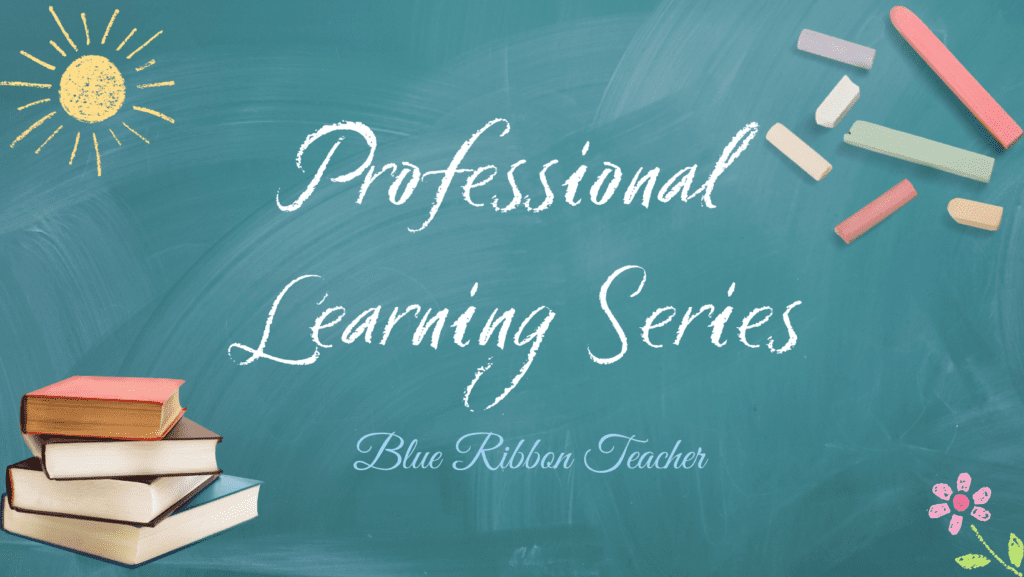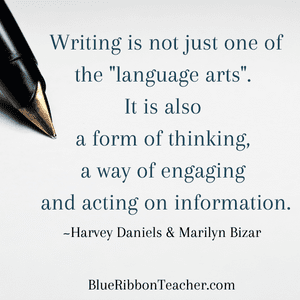Teaching Struggling Writers
One of the instructional challenges teachers face is teaching struggling writers how to write. I don’t know about your training, but in the education programs I have reviewed, there are no courses on “how to teach writing”. Teaching struggling writers can be a challenge. Each student has personal interests, strengths, skills, strategies, and challenges. Identifying those writing strengths and building upon them is key to engaging students in writing. But what happens when students do not like to write? How do you help struggling writers?
Do you have students who struggle with writing: content, style, form, process, mechanics, or characteristics of great writing? Maybe they complain, argue, or have a sour attitude about writing and don’t turn in any or very little writing assignments. How about when you walk over to check on their progress, they say . . . “I don’t know what to write about” or “I have nothing to write about”.
How to Help Struggling Writers
Do you have these students? Every year? Perhaps you struggle with finding the “secret sauce” to help your 25+ diverse students be successful writers because they all have different needs. Can you relate?

This post may contain affiliate links, and I may earn compensation
when you click on the links at no additional cost to you.
Let’s take a look at some of the reasons students struggle to write and examine how instructional strategies can be used to support these students.
This post is the first session of a four-part Professional Learning Series.
Reason #1: Teaching Struggling Writers Process
One reason writing is a challenge is that students are not certain of the process of writing. Now think about when your students or children were younger. They would pick up a crayon or pick up a pencil and start writing something. They did this because they saw other siblings and adults do the same thing. Right!
Then the children began to draw some lines and circles – we equate it to scribbling, but the child has something specific to say about what he/she wrote and can sometimes tell you. The work was celebrated with success and placed on the refrigerator. Soon anytime the child wrote something down, he/she received more praise! Yes!! The child began to communicate in writing, feeling great with the reactions, and did more.
THEN the child enters school. Now the child learns there is a certain way to write, there are lines to write on, there are letters to form, then words to write, and now the child isn’t having fun writing. His/her work is being corrected and has to redo the work. UGH!!
Here come the tears, ripped-up papers, holes from erasures, etc. You know what I’m talking about. Surely you’ve seen this not only in early childhood education, but elementary education. I’ve even seen middle schoolers crumble up their paper and toss it in the garbage can or practice basketball skills, which is way more fun!

Questions About Struggling Writers?
Why do students exhibit these behaviors? Students are thinking – now I need to write something different, how do I do this . . . it made sense before . . . why not now, people were happy with what I wrote before . . . why not now. I’m writing a story and what I have written is exactly what I want to say, why do I need to rewrite it? What does the teacher expect me to do? I hate writing!
Strategy #1 to Support Writers
My quick strategy to overcome this challenge is to just let them write! Just getting thoughts on paper is the biggest hurdle for struggling writers. It doesn’t have to be perfect. Take what they have written and put it on the refrigerator. This display helps them to feel proud about what has been written. Remember, if there is nothing available for you to read, how will you know how to support the student’s developing writing skills?
BUILD CONFIDENCE FIRST . . . THEN LEARNING HAPPENS!
Dr. Annette Durbin
My Personal Writer Struggles
This was me as a kid. I always wrote what I thought the teacher wanted me to write and always had errors. I didn’t know how to take my thoughts and get them down perfectly because it always seemed as though I had to fix something whether it was content, organization, or mechanics. Fast forward to my English 101 college experience. I remember the first paper I wrote about a pencil talking to paper, and I really struggled with this piece. I did the best I could and received some comments from my professor.

Her TIP – write how you speak. What? That’s it? Okay, that tip worked for me and later for my own students. Now when I let my students know they can just write down their thoughts – and forget about everything else – my students’ writing improved. Yes, what they turned in wasn’t perfect, but was accepted. I used this piece as baseline writing and pulled some lessons from their work that I would go over later. Now my students were less stressed about writing and felt better that an assignment was turned in.
Reason #2: Teaching Struggling Writers
Another reason writers struggle is they don’t always know where to begin or how to proceed. They have some thoughts in their brain, but they’re not quite certain how they’re supposed to get those thoughts on paper. I can orally share my thoughts, but whenever I have to transfer those thoughts to paper, that’s more challenging.
Strategy #2 to Support Writers
Another strategy to help those students start writing is oral sharing. When we write, we typically do a pre-write, or if you’re like me, I draft that letter or email in my mind before I write. I may even bounce some ideas around with a friend.
How many of you can raise your hand to this strategy? Right?
Students need this same time to process their thoughts and think about how to start sharing those thoughts. Use this oral sharing strategy to support your students. I have found that students who struggle with writing have less frustration when they’ve had an opportunity to talk with a friend.
Now, let’s think about your multilingual language learners (MLs). They need time to process the question or topic, have a go at communicating their thoughts, jot some notes down, and then be ready to articulate the information. If they are more monolingual than bilingual, let these MLs write in their first language. Google Translate is a lifesaver! A caveat with this oral sharing strategy, I have found the writing that students create is more organized and holds better content.
How to Support Students to Overcome Writer’s Block
Are you finding value? I have two more reasons and strategies to share, but I don’t want you to miss out on digging deeper into the struggles students have with writing and strategies to help students overcome this challenge.
The complete Professional Learning Series includes four videos:
In this Professional Learning Series, we learn about why students struggle and discuss several strategies you can easily implement to help your struggling writers. Below are the four modules outlining the Professional Learning Series.

First Module: Why students experience writer’s block. Initial strategies to support writers.
Second Module: Learning from the experts with model texts to unlock writer’s block.
Third Module: Differentiating with Multiple Intelligences to unlock writer’s block.
Fourth Module: Priming the brain for writing and next steps for writers.
Video: Module 1
Check out this video featuring Session 1, where I go into more detail about supporting students to overcome writer’s block from the student and teacher perspective.
If this video was valuable, check out the entire Professional Learning Series.
Reason #3: Teaching Struggling Writers
Let’s look at another reason students struggle with writing. Writing doesn’t take place all at once in fluid sentences and organized paragraphs. What? Do you mean writing takes more than fifteen minutes? Yes. This challenge comes as students begin writing their pieces and are now making corrections because that’s what we do as teachers, we help students identify errors and fix them. This equates to learning.
Strategy #3 to Support Writers
An effective strategy for students is to use an analogy – usually tying the shoes, a sports-related skill (use one the student enjoys), driving a car, etc. are great analogies to use. You know your student, so connect with him/her in this example. Help the student see that anything worth doing is worth practicing, even writing.
Another great strategy for this challenge is to start small. Instead of the student revising the entire writing piece for all errors, focus on just one paragraph and one error type. Let the student use highlighters to locate the errors and colored pencils to make corrections. Instead of rewriting the entire piece, have the student just submit that one paragraph.

Now, like most teachers, I always like to give the students a challenge, and students like those challenges, too. I will challenge the student to rework another paragraph and make the same error corrections or even correct a different type of error. I will only include one error type (content, style, form) and one mechanic error to correct at any time. This way students are practicing his or her learning, not feeling overwhelmed, and are more apt to complete the assignment successfully and feel accomplished.
Reason #4: Teaching Struggling Writers
Alright, we are coming down to the last big challenge for students. The more complex the subject or topic, the more unpredictable the journey. Which student are you thinking about right now who looks at a large project and begins to hyperventilate: How much time do I have, what time does recess start, I don’t know what to write or where to start, I’m never going to get this done, and the negativity goes on and on. Negative thoughts lead to negative action, so the student sits there in frustration, not knowing how to start or what to do. Sound familiar! Yes, the student probably feels like he/she is in “writer’s jail”.
Here are some of my favorite instructional writing books!
Knowing that the student has this struggle, it’s important to plan ahead. Additionally, often what I have found is that students think that what they write down on paper is perfect the first time. Yes, this goes back to the students’ early days of writing. So those strategies to overcome some challenges I shared earlier will certainly prepare the student for a longer, more complex piece of writing.
At this stage, the student just struggles with writing so much information. Once students get to a complex piece of writing, they become overwhelmed with so much to write. Do you see how these struggles build upon each other and how the strategies build to give confidence first, then learning can happen? Remember that brain science – STEM vs. FRONTAL lobe?
Strategy #4 to Support Writers
A strategy to support the student with these challenges builds upon an earlier strategy. Breaking down the task into small bite-sized pieces and mapping out a plan is not only a great strategy for writing, but also for completing larger projects. Perhaps a graphic organizer or timeline is a strategy that your student can use.
Think about a project you have to complete. How many of you have a checklist? I know I am a checklist person and love marking those boxes. I will often add a task that was not on the list, and check that task off.
How many of you do that, too? Yes, I know you are out there!
Providing a visual will assist the student in completing a larger task. This helps the student see the big picture and the path to get to the goal line. SUCCESS!!

Related Resources to Support Struggling Writers
I have gathered several resources to support writing instruction for your students. There are many more, but these will get you started on your journey.
How to Teach Writing Composition
Teaching Struggling Writers: Final Thoughts
Alright, these are just some challenges that most students will experience, but as we know, not every single student is the same, which is why teaching writing is challenging for teachers. I’ve outlined several instructional strategies that can be used to provide support for your writers to help them be successful.
I’d love to hear how these strategies are supporting your writers. Leave a comment sharing your success and additional questions about writing instruction.




Pingback: Sarah